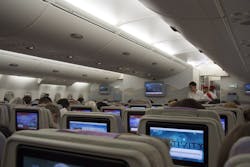How airlines give you internet access at 35,000 feet — and why it still needs a lot of work
ATLANTA - Flights used to be a chance to sit back (albeit a bit cramped) and watch a recently released movie or catch up on some reading. Now they're just another place to log on. Delta and United each host more than 1.5 million inflight WiFi sessions a month, the airlines told CNN Business, while JetBlue said its service is used by "millions of customers" every year. Southwest declined to share specific numbers but said inflight Wifi is "popular," Rishi Iyengar reports for CNN Business. Continue reading original article.
The Military & Aerospace Electronics take:
7 September 2022 - Verified Market Research says that in-flight WiFi services is currently a $5 billion business. By 2030, the research firm projects it to grow to $12 billion.
Internet connectivity onboard passenger jets has been spotty as air-to-ground technology relies on RF connectivity to towers, and everyone onboard the plane needs to share the same connection. This results in everyone paying for an internet connection for the flight has to share a 5 megabit per second service. Iyengar's piece notes that the median connectivity speed for mobile broadband is 30mb per second.
Space-based SATCOM connections have been in place for nearly a decade. Coupled with air-to-ground connections, passengers are seeing a better product, but the expense of launching satellites means an in-cabin internet experience that equals that on the ground means we'll likely be waiting for the equipment to catch up to the demand.
Related: Viasat tapped by Virgin Atlantic to provide in-flight connectivity for its new A330 fleet
Related: Can the tracking of in-flight catering improve airline sustainability?
Related: Starlink is coming to Hawaiian Airlines in a bid to try and fix in-flight Wi-Fi
Jamie Whitney, Associate Editor
Intelligent Aerospace
